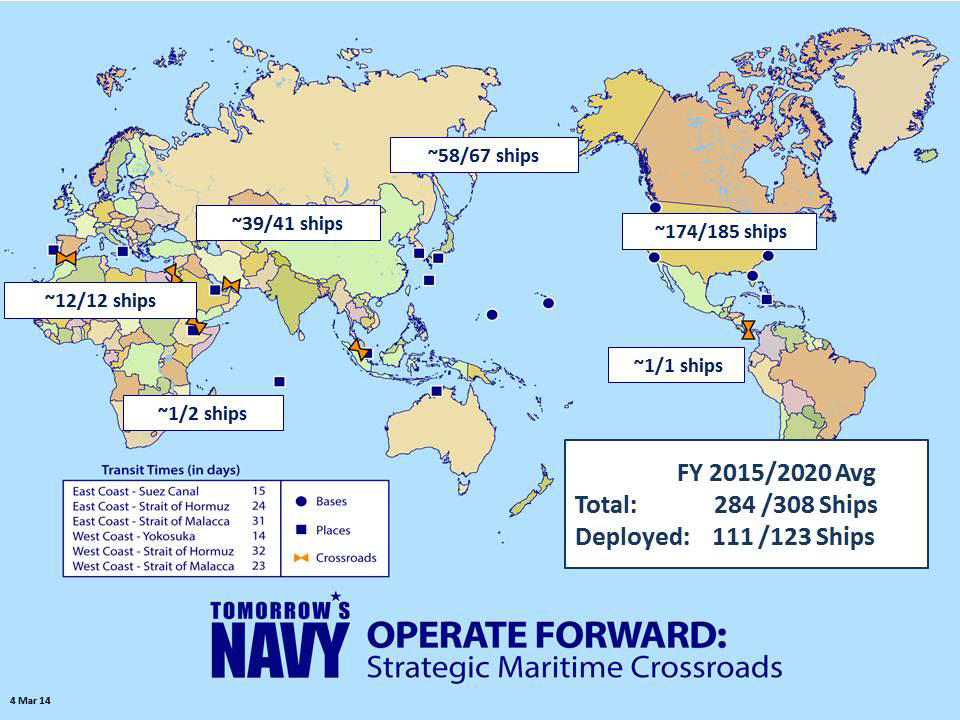| 2020年的美國海軍會是什麼樣? |
| 送交者: SDUSA 2014年04月04日19:08:50 於 [軍事天地] 發送悄悄話 |
|
U.S. Navy’s top officer previews future battle fleet … and budgetary risk
In six years, the U.S. Navy will have more ships, more cutting-edge weaponry and tactics and a greater ability to both show the flag in peacetime and sink enemy fleets during war. That’s what Adm. Jonathan Greenert, the Chief of Naval Operations, told the U.S. Senate in late March. But Greenert’s sweeping vision of a bigger and deadlier fleet came with a chilling caveat. Congress’ refusal to pass adequate budgets could undermine the expanding Navy, the admiral warned, robbing it of vital training and maintenance funds and forcing it to decommission some of its most powerful warships. Today’s fleet numbers 290 front-line warships plus more than a hundred ships in the quasi-military Sealift Command and in ready reserve, manned and supported by 600,000 active and reserve sailors and Navy civilians. Total cost: $150 billion a year, a sum that also pays for the entire U.S. Marine Corps. Right now the sailing branch forward-deploys 104 warships, according to Greenert—48 ships in the Western Pacific, 32 in the Middle East, 21 in European waters, two off of East Africa and a single vessel in Latin America. The balance of the battle fleet—185 ships—is in the U.S. for maintenance and training.  The 2020 battle fleet will be bigger—308 vessels, Greenert vowed. No fewer than 123 will be on deployment at any given time, concentrating in Asian waters. Sixty-seven warships will sail the Pacific to deter a rising China. Forty-one will patrol the Middle East. Over the next six years, the Navy will reduce the number of ships in Europe by nearly half and roughly hold steady off Africa and Latin America. The mix of ships will change. The Navy has a long-term requirement for 306 front-line warships: 11 nuclear carriers; 11 assault ships; 22 other amphibious-warfare vessels; 52 small surface combatants including Littoral Combat Ships, frigates and mine-hunters; 88 destroyers and cruisers; 48 attack submarines; 12 ballistic missile submarines; 29 logistics ships and 33 support ships including command and salvage vessels.  The current fleet has an excess of submarines but a big shortfall in small combatants, owing to delays acquiring Littoral Combat Ships and to the Navy’s rushed disposal of old frigates and mine-hunters. In 2020, there willalso be a small shortage of assault ships, destroyers and cruisers, Greenert warned. “This force structure capacity provides less margin for error.” Budgetary woes could widen the gaps. Today’s fleet keeps two flattops and two assault ships forward plus another three carriers and three assault ships on stand-by—a force sufficient to wage one war and deter another, according to Greenert. If Congress doesn’t finally cancel the automatic “sequestration” budget cuts by 2016, the Navy could have no choice but to decommission an aircraft carrier and its air wing. That, the admiral said, “would leave us with a Navy that is capable of one … contingency,” rather than the current two. The budget squeeze also threatens the Navy’s efforts to counter high-tech enemy air defenses including long-range surface-to-air missiles and radar-evading stealth fighters. To beat the latest Russian, Chinese, North Korean and Iranian defenses, the Navy is assembling sophisticated “fire-control” networks of carrier-launched armed drones, EA-18G electronic warfare planes and F-35C stealth fighters that scout ahead for missile-armed F/A-18E/F fighter-bombers. New E-2D command planes packing high-tech sensors and radios watch over and coordinate everything. Sequestration is preventing the sailing branch from buying several dozen EA-18Gs it says it needs—and is also slowing down the acquisition of F-35Cs and, arguably more critically, E-2Ds. Greenert said that by 2020 he wants to outfit six of the Navy’s 10 carrier air wings with E-2Ds and, by extension, the next-generation fire-control net. Sequestration reduces the roll-out to just four air wings over the next six years. To be clear, even after big reductions, the U.S. Navy would still be by far the world’s most powerful maritime force. But that doesn’t mean Greenert isn’t worried. Budget cuts could reduce capacity and increase risk. “I remain deeply concerned,” the admiral said. David Axe’s new book Shadow Wars is out. Sign up for a daily War is Boring email update here. Subscribe to WIB’s RSS feed here and follow the main pagehere. |
|
|
|
|
 | |||
|
 |
| 實用資訊 | |
|
|
|
|
| 一周點擊熱帖 | 更多>> |
|
|
|
| 一周回復熱帖 |
|
|
|
|
| 歷史上的今天:回復熱帖 |
| 2013: | 俄媒稱元級潛艇噪音大激起中國再購俄技 | |
| 2013: | 為何無人談論北朝鮮要開戰的事?國內論 | |
| 2012: | 釣魚島一觸即發:中國打出王牌,俄率先 | |
| 2012: | 連帕勞都敢對中國開槍了 | |
| 2011: | 日本正在向公海放毒(高核輻射水),此 | |
| 2011: | 日本人應先將核污染毒水淨化再入海否則 | |
| 2010: | 中國出了個毛澤東是上蒼對中華民族的眷 | |
| 2010: | 大連的‘瓦式’航母開始在刷油漆了 | |
| 2009: | G20中國談判路線犯下重大錯誤 | |
| 2009: | 殲十迫降等系列事故背後秘密令美日不安 | |






